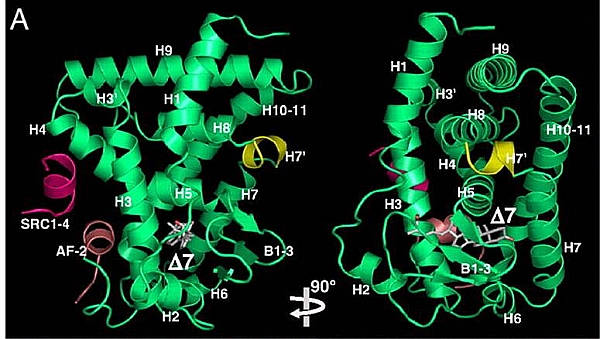The group of David Mangelsdorf at the University of Texas Southwestern Medical Center and collaborators recently solved the structure of the nuclear receptor DAF-12 from the nematode parasite, Strongyloides stercoralis, and identified nuclear receptors as new therapeutic targets against parasitic nematodes. Parasitic nematodes affect the health of over one billion people worldwide. Treatments are unreliable against severe forms of S. stercoralis infection, and resistance to common treatments is increasing. The investigators showed that a conserved nuclear hormone receptor signaling pathway through DAF-12 governs stage 3 infection larvae (iL3), and that the administration of DAF-12 ligands, steroid hormone-like dafachronic acids, markedly reduced the pathogenic iL3 population, indicating the potential use of DAF-12 ligands to treat disseminated strongyloidiasis. The structure of the DAF-12 ligand-binding domain with a coactivator peptide and a dafachronic acid may guide development of better therapeutics.
 |
Figure: Crystal structure of the DAF-12 ligand-binding domain with coactivator peptides (red and salmon) and the Δ7 ligand. |
Citation:
Wang, Z, Zhou, XE, Motola, DL, Gao, X, Suino-Powell, K, Conneely, A, Ogata,
C, Sharma, KK, Auchus, RJ, Lok, JB, Hawdon, JM, Kliewer, SA, Xu, HE,
Mangelsdorf, DJ. Identification of the nuclear receptor DAF-12 as a
therapeutic target in parasitic nematodes, Proc. Natl. Acad. Sci. USA 106
(23), 9138-9143 (2009). DOI: 10.1073/pnas.0904064106